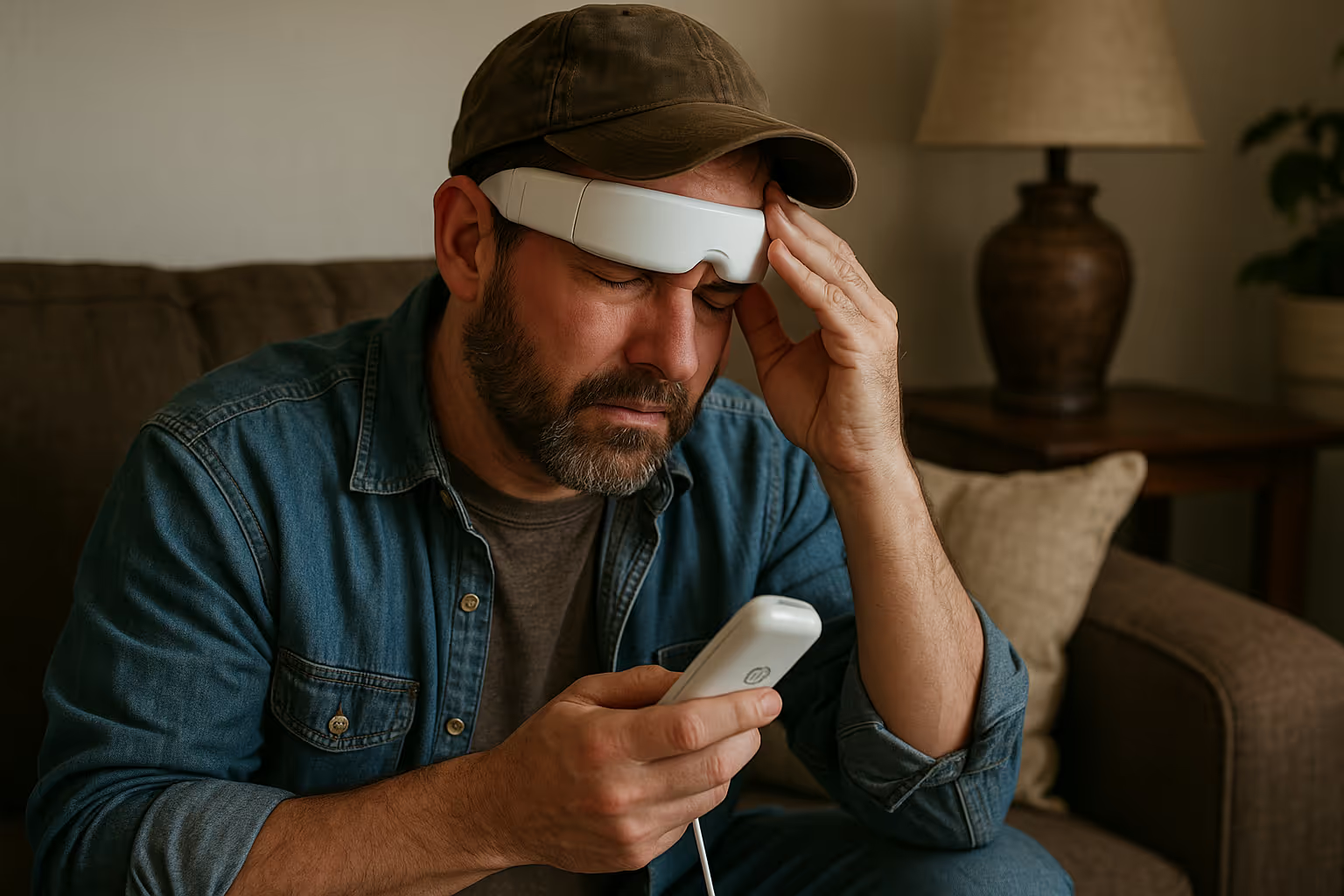Online Migraine Treatment
Speak with a licensed provider and get a personalized treatment plan, including prescriptions if needed, in minutes.
Estimated wait time: 5 minutes or less


What is a migraine?
A migraine is a type of headache that can cause severe throbbing pain or a pulsing sensation, usually on one side of the head. It's often accompanied by nausea, vomiting, and extreme sensitivity to light (photophobia) and sound (phonophobia). Migraine attacks can last for hours to days, and the pain can be so severe that it interferes with your daily activities.
Symptoms of a migraine
- Severe, throbbing or pulsing head pain (often unilateral)
- Nausea and/or vomiting
- Increased sensitivity to light (photophobia)
- Increased sensitivity to sound (phonophobia)
- Increased sensitivity to smell (osmophobia)
- Auras (visual disturbances like flashing lights, zigzag lines, or blind spots)
- Fatigue
- Irritability
- Difficulty concentrating
What causes a migraine?
The exact causes of migraines are not fully understood, but they are believed to be related to genetic and environmental factors. Triggers can vary widely among individuals and may include:
- Stress
- Changes in sleep patterns
- Certain foods or drinks (e.g., aged cheeses, processed meats, caffeine)
- Hormonal changes (in women)
- Weather changes
- Sensory stimuli (e.g., bright lights, loud noises, strong smells)
- Dehydration
- Skipping meals
How we diagnose a migraine?
Diagnosing a migraine typically involves:
- A thorough review of your symptoms and medical history by a licensed provider.
- Discussion of your headache patterns, triggers, and any accompanying symptoms or previous migraine workup.
- Ruling out other conditions that might cause similar symptoms. No specific lab test can diagnose migraines.
Effective online treatment for migraines
Migraines are treatable, and HLTHi provides quick access to personalized online treatment plans, allowing you to get relief fast and manage future attacks. Our providers can help you understand your triggers, develop coping strategies, and, if appropriate, prescribe medication.
Common online treatment options
- Acute Treatment: Medications taken at the onset of a migraine to stop it or reduce symptoms.
- Preventive Treatment: Medications taken regularly to reduce the frequency and severity of migraine attacks.
- Lifestyle Modifications: Guidance on identifying and avoiding triggers, stress management techniques, and sleep hygiene.
Migraine medications we prescribe
After evaluating your symptoms and medical history, your doctor may prescribe medications for acute relief or prevention of migraines. These may include:
Acute Migraine Medications:
- Triptans: (e.g., Sumatriptan, Rizatriptan, Zolmitriptan) – Prescribed to abort migraines by constricting blood vessels and blocking pain pathways in the brain.
- NSAIDs: (Nonsteroidal Anti-inflammatory Drugs like Ibuprofen, Naproxen) – Can be prescribed in higher doses than over-the-counter for mild to moderate migraines.
- Anti-emetics: (e.g., Ondansetron) – Prescribed to relieve nausea and vomiting.
Preventive Migraine Medications:
- Beta-blockers: (e.g., Propranolol) – Can help reduce migraine frequency.
- Antidepressants: (e.g., Amitriptyline) – Some types can help prevent migraines.
- Anti-seizure medications: (e.g., Topiramate) – Also used for migraine prevention.
- CGRP Inhibitors: (e.g., Rimegepant (Nurtec ODT), Ubrogepant (Ubrelvy)) - Newer classes of medications that target CGRP, a peptide involved in migraine pain pathways. These may be prescribed based on medical necessity and provider discretion.
How to care for a migraine
- Rest in a quiet, dark room.
- Apply a cold or warm compress to your head or neck.
- Stay hydrated.
- Avoid known triggers.
- Practice relaxation techniques (e.g., deep breathing, meditation).
- Follow your prescribed medication regimen as directed.
- Keep a migraine diary to track triggers and effectiveness of treatments.

Easy steps to get virtual migraine care
Our virtual care process is designed to be simple and convenient, providing you with expert healthcare from the comfort of your home. Whether you're dealing with minor symptoms or need guidance on a more persistent issue, our licensed providers are ready to help. Here's how easy it is to get started:
Step 1.

Step 2.
Step 3.
Step 4.
Step 5.
Common questions you may have about migraines
What are tips for instant migraine relief?
To help alleviate migraine pain quickly and find instant relief, you can try several methods:
- Find a Dark, Quiet Place: Reduce sensory input by resting in a quiet, dimly lit or dark room.
- Apply Temperature Therapy: Place an ice pack wrapped in a cloth on your forehead, temples, or the back of your neck. Some individuals find a warm compress helpful as well.
- Hydrate: Sip water, as dehydration can trigger or worsen migraines.
- Moderate Caffeine Intake: A small amount of caffeine can sometimes help in the early stages of a migraine, but avoid overdoing it.
- Practice Relaxation Techniques: Deep breathing, meditation, or progressive muscle relaxation can help reduce tension.
- Over-the-Counter Pain Relievers: For mild to moderate migraines, NSAIDs like ibuprofen or naproxen, or combination pain relievers, may provide relief.
- Consider Gentle Massage: Massaging your temples, scalp, or neck can sometimes ease tension.
- Try Ginger: Ginger powder may help relieve migraine pain and associated nausea.
- Connect with a Telehealth Provider: For rapid assessment and potential prescription of acute migraine medication, consider using a telehealth service like HLTHi's on demand doctors. You can connect with a board-certified provider quickly, often within minutes, to discuss your symptoms and get a prescription sent to your local pharmacy.
What if my migraines are severe or I need emergency care?
What information should I have ready for an online migration visit?
To help your provider best assess your condition and create a personalized treatment plan, it’s helpful to be prepared to discuss:
- Your symptoms: Detail the pain location, severity (on a scale of 1-10), duration, and any accompanying symptoms like nausea, vomiting, or sensitivity to light, sound, or smell.
- Migraine frequency: How often you experience migraines.
- Potential triggers: Anything you’ve noticed that might bring on your migraines.
- Past treatments: Any medications (prescription or over-the-counter) or other remedies you’ve tried, and whether they were effective.
- Relevant medical history or migraine workup: This is crucial. Be ready to share details about any specialist visits (e.g., neurologist), past medical exams, lab tests, or imaging studies (like CT scans or MRIs of the brain) you’ve had for your migraines. This helps our providers understand your history and rule out other conditions.
.svg)

